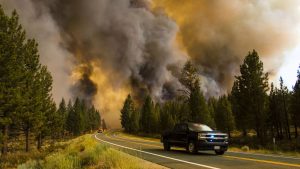10 Disproportionate Impacts of Wildfires

Globally, we know that natural disasters impact millions of people, but what we often do not take into account is the fact that those disasters impact low-income and communities of color in a more drastic way than high-income and predominantly white communities. Numerous studies and statistics have shown that the recovery process from traumatic events such as wildfires is more difficult for lower-income people as well as communities of color. For instance, when Hurricane Katrina struck New Orleans, African Americans had to bear the disproportionate impact on life and property: “damaged areas comprised 46% Black people versus 26% in undamaged areas, and 84% of missing people were Black in a city that is only 68% Black” [1]. It becomes harder for people to recover due to the fact that many can’t afford the precautions against wildfires – such as insurance, since insurers are getting stricter about what you need to do to qualify for coverage [2]. Without the financial means, families cannot afford things such as tree trimming, bush removal, or other fire mitigation services that could mean the difference between a low severity under-burn and a severe wildfire [3].
A paper published by the National Bureau of Economic Research analyzed 90 years of natural disaster data. Its analysis showed that major catastrophes increase a county’s poverty rate – which is the percentage of people living below the poverty line. This is because natural disasters encourage those who are well off to leave while making those with low incomes poorer [4]. One prime example of a family struggling through a wildfire is Wendy and Norm Alvarez. Wendy and Norm had a unique living arrangement in Redding, Ca. Norm is a carpenter and had taken care of an antique dealer’s house for years. The place was on the outskirts of town. In June 2018, the Carr Fire forced Norm and Wendy to evacuate their home. The next day they were watching the news and saw footage of their neighborhood where some of the houses stayed untouched while theirs was completely destroyed. Nearly every one of their belongings was burned. The couple is one out of many that did not have insurance, so financially “[they] are in a position [they] haven’t had to be in” [5]. The long-term effects of natural disasters like fires take a toll on families and communities financially – and many may never recover.
Health Impacts
So what effects of wildfires do those people have to struggle through? If we look at the impacts of wildfires – more specifically the smoke and ash – through the medical/health lens, we’ll see that there are numerous short-term and long-term impacts. Particles that make up smoke are tiny meaning that our bodies have difficulties filtering the harmful particles out of our airways – this leads to many health problems, such as irritation to the eyes, nose, and lungs, and can cause stress to our hearts [6]. (For more information see this chapter). Those fine particles are respiratory irritants, and if you are exposed to high concentrations of those particles, you can also develop “persistent coughing, phlegm, wheezing, and difficulty breathing” [7]. Going back to what was stated previously, many can’t afford insurance, this also includes health insurance. The impacts on a person’s health can be quite drastic especially when one lives in poor living conditions. Therefore, the health impacts of wildfires are disproportionately experienced. This is becoming a prominent issue because of climate change, which is prolonging the wildfire season and increases wildfire prevalence and severity [8].
Another major threat from forest fires and the smoke is carbon monoxide – which is a “colorless, odorless gas most common during the smoldering stages of a fire and in close proximity to the fire” [9]. Carbon monoxide is dangerous due to its ability to reduce oxygen delivery to the body’s organs and tissues which can lead to things such as “headaches, nausea, dizziness and, in high concentrations, premature death” [10].
This past year, Seattle has had the worst air quality in the world with an AQI over 240 – beating famously polluted cities such as Beijing and Delhi – which was the cause of forest fires raging in the Cascade Mountains [11]. This is another reason why it’s so important to acknowledge predicaments such as this one. With the drastic changes that climate change brings, we must acknowledge that the impacts are not felt equally throughout.
- Davies, Ian. “The Unequal Vulnerability of Communities of Color to Wildfire.” PLOS ONE, 2 Nov. 2018, journals.plos.org/plosone/article?id=10.1371/journal.pone.0205825. Accessed 15 November 2022. ↵
- Segarra, Marielle. “Wildfires disproportionately affect low-income Americans, study finds” "Wildfires Disproportionately Affect Low-Income Americans, Study Finds". Marketplace, 2022, https://www.marketplace.org/2022/08/03/wildfires-disproportionately-affect-low-income-americans-study-finds/. Accessed 21 Nov 2022. ↵
- Davies, Ian. “The Unequal Vulnerability of Communities of Color to Wildfire.” PLOS ONE, 2 Nov. 2018, journals.plos.org/plosone/article?id=10.1371/journal.pone.0205825. Accessed 15 November 2022. ↵
- Harnett, Sam. "Low-Income Communities Struggle To Recover After A Wildfire". NPR.Org, 2018, https://www.npr.org/2018/09/19/647606049/low-income-communities-struggle-to-recover-after-a-wildfire. Accessed 16 Nov 2022. ↵
- Harnett, Sam. "Low-Income Communities Struggle To Recover After A Wildfire". NPR.Org, 2018, https://www.npr.org/2018/09/19/647606049/low-income-communities-struggle-to-recover-after-a-wildfire. Accessed 16 Nov 2022. ↵
- Mendenhall, Jared. “Wildfire’s Impact on Our Environment.” Utah Department of Environmental Quality, 30 Aug. 2019, https://deq.utah.gov/communication/news/wildfires-impact-on-our-environment. Accessed 23 October 2022. ↵
- “Health Effects Attributed to Wildfire Smoke.” US EPA, 17 Nov. 2021, www.epa.gov/wildfire-smoke-course/health-effects-attributed-wildfire-smoke. Accessed 23 October 2022 ↵
- Reid, Colleen. “Critical Review of Health Impacts of Wildfire Smoke Exposure.” ENVIRONMENTAL HEALTH PERSPECTIVE, 1 Sep. 2016, https://ehp.niehs.nih.gov/doi/full/10.1289/ehp.1409277. Accessed 15 November 2022. ↵
- Association, American. "How Wildfires Affect Our Health". Lung.Org, 2022, https://www.lung.org/blog/how-wildfires-affect-health. Accessed 1 Dec 2022. ↵
- Association, American. "How Wildfires Affect Our Health". Lung.Org, 2022, https://www.lung.org/blog/how-wildfires-affect-health. Accessed 1 Dec 2022. ↵
- Osaka, Shannon. “Why Seattle air quality is the worst air quality in the world.” The Washington Post, 20 Oct 2022. https://www.washingtonpost.com/climate-environment/2022/10/20/seattle-air-quality-worst-in-world/. Accessed on 2 Dec 2022. ↵

